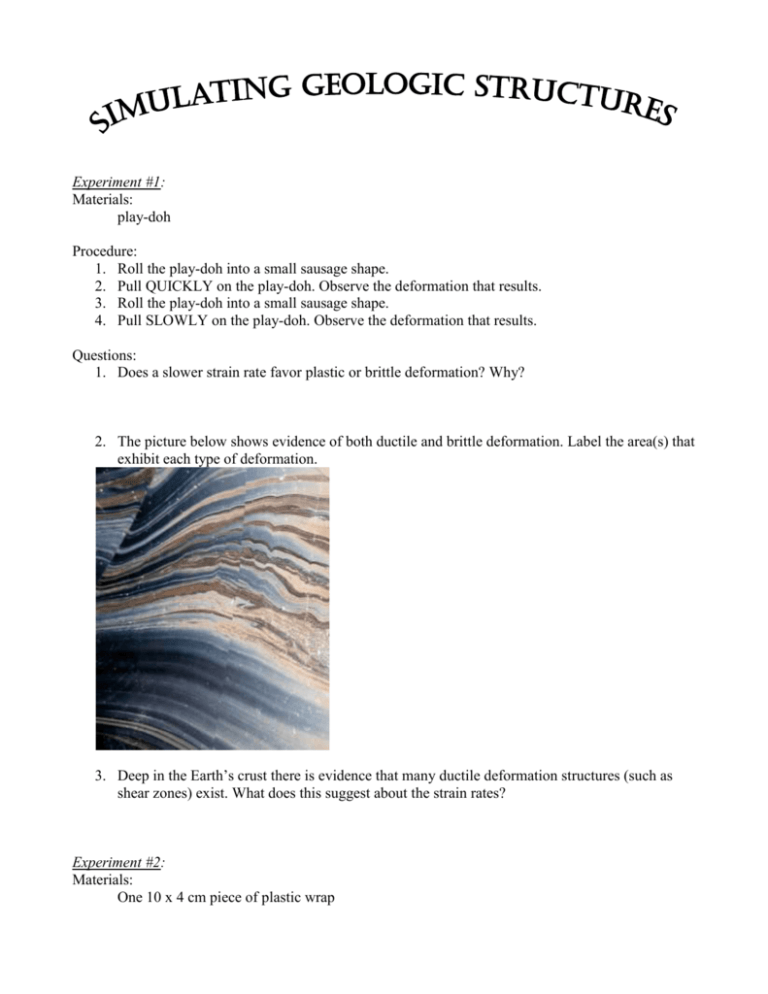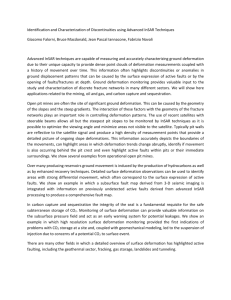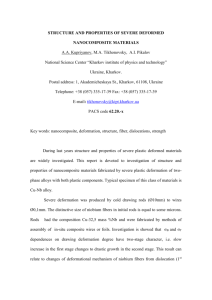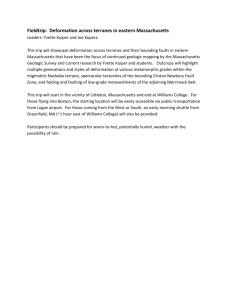play doh lab
advertisement

Experiment #1: Materials: play-doh Procedure: 1. Roll the play-doh into a small sausage shape. 2. Pull QUICKLY on the play-doh. Observe the deformation that results. 3. Roll the play-doh into a small sausage shape. 4. Pull SLOWLY on the play-doh. Observe the deformation that results. Questions: 1. Does a slower strain rate favor plastic or brittle deformation? Why? 2. The picture below shows evidence of both ductile and brittle deformation. Label the area(s) that exhibit each type of deformation. 3. Deep in the Earth’s crust there is evidence that many ductile deformation structures (such as shear zones) exist. What does this suggest about the strain rates? Experiment #2: Materials: One 10 x 4 cm piece of plastic wrap Procedure: 1. Measure the length and width of the plastic strip. Length Width 2. SLOWLY pull on the plastic strip. Observe the deformation that results. 3. Measure the length and width after the strip is deformed. Length Width Questions: 1. What type of stress did you apply? 2. Explain how the landscape in the picture below could result from a similar type of deformation. Experiment #3: Materials: 2 containers of play-doh, one room temperature and one refrigerated 2 textbooks 1 stop watch 1 ruler Procedure: Read first!!! 1. Remove the room temperature play-doh from the container. Do not change the shape of it. Stand it up on the table. 2. Measure and record the diameter and height of the room temperature play-doh column. 3. Remove the refrigerated play-doh from the container. Do not change the shape of it. Stand it up on the table. 4. Measure and record the diameter and height of the refrigerated play-doh column. 5. Place a textbook on top of each play-doh column at the same time. 6. Remove the textbooks, at the same time, after 30 seconds. 7. Measure and record the diameter and height of each column. temperature Initial diameter, cm Initial height, cm Deformed diameter, cm Deformed height, cm Room temperature play-doh Refrigerated play-doh Questions: 1. Did the temperature of the play-doh have any effect on the observed deformation? If so, what? 2. Was the applied stress equal for both samples of play-doh? Explain. 3. Based on your observations, is an increase in temperature more likely to cause materials to undergo plastic or brittle deformation? 4. Consider what you know about deformation, would you expect rock of different temperatures to behave in a similar fashion to play-doh? Experiment #4: Materials: 4 different colors of play-doh Procedure: 1. Flatten each of the colors of play-doh into a sheet about ½ cm thick. 2. Each color represents a different layer of sedimentary rock. Decide on an age sequence based on the color play-doh. 3. Layer the play-doh with the “oldest” layer at the bottom and each subsequent layer being a “younger” layer. 4. 5. 6. 7. 8. Measure the length and height of the layer stack. Draw and label a “before” deformation diagram. Apply a compressional differential stress to the layers until deformation occurs. Draw and label a diagram showing the deformation that occurred. You will need this structure for the next experiment…… Length of layer stack, cm Height of layer stack, cm Before deformation After deformation Before deformation after deformation Questions: 1. What happened to the length of the layers after the deformation? Why? 2. What happened to the height of the layers after the deformation? Why? 3. What type of folding resulted from the deformation? 4. Explain what might have caused the deformation in the picture below. Experiment #5: Procedure: 9. Continue to add stress to the stack in experiment #4. 10. Observe the resulting folded structure. Draw a diagram below. 11. You will need this structure for the next experiment…… Questions: 1. What type of folding is shown in the stack now? 2. Explain what might have caused the deformation in the picture below. Experiment #6: Procedure: 12. Use the plastic knife to cut the top off of the stack so that all of the layers are exposed across the surface of the stack. 13. Draw and label a diagram showing the top surface of the stack. 14. Label the ages of the rocks represented by each layer. Questions: 1. Observe the layers that make up the anticline. Describe the age sequence of these layers. 2. Observe the layers that make up the syncline. Describe the age sequence of these layers. 3. Label the picture below with the correct age sequence.






